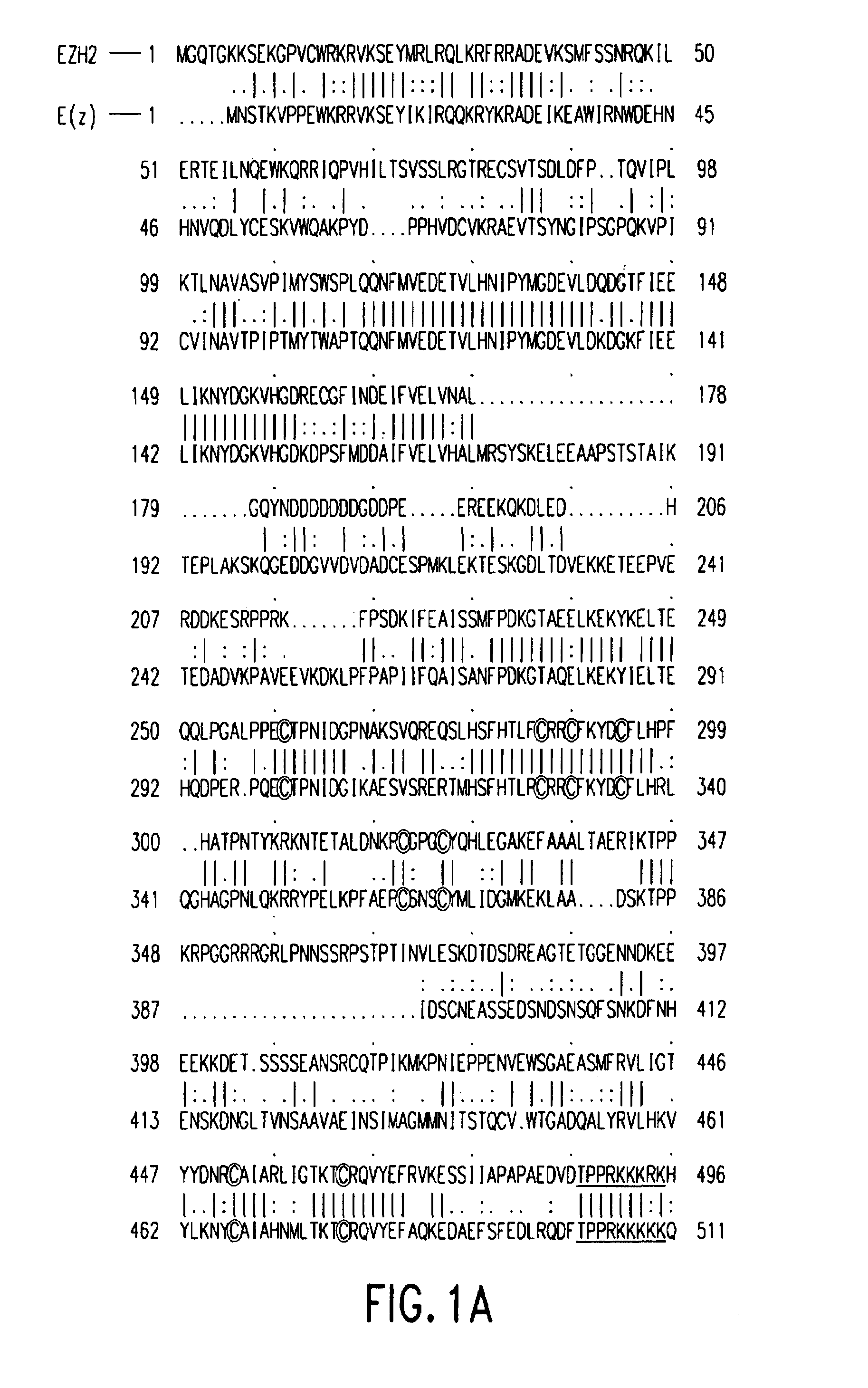Chromatin regulator genes
a technology of chromatin regulators and genes, applied in the field of chromatin regulator genes, can solve the problems of uncontrollable proliferation, inability to understand the interdependence of the different histone tail modifications for the integration of transcriptional output or higher-order chromatin organization, and the knowledge of mammalian gene products which interact with chromatin is still very limited
- Summary
- Abstract
- Description
- Claims
- Application Information
AI Technical Summary
Benefits of technology
Problems solved by technology
Method used
Image
Examples
example 1
Preparation of a cDNA Library
[0079]Human B-cell-specific cDNA library as described by Bardwell and Treisman, Genes &Dev. 8:1644–1677 (1994), was prepared by isolating poly(A)+-RNA from human BJA-B-cells, reverse-transcribing it by poly(dT)15, priming and converting it into double-stranded cDNA. After the addition of an EcoRI adapter of the sequence 5′ AATTCTCGAGCTCGTCGACA (SEQ ID NO:6), the cDNA was ligated into the EcoRI site of the bacteriophage gt10. The propagation and amplificiation of the library were carried out in E. coli C600.
Preparation of DNA Probes
[0080]Drosophila DNA probes coding for the conserved SET domains of E(z) and Su(var)3-9 were prepared on the basis of the published Drosophila sequences (Jones and Gelbart, MCB 13(10):6357–6366 (1993); Tschiersch, et al., Embo J. 13(16):3822–3831 (1994)) by polymerase chain reaction (PCR): 1 μg of Drosophila melanogaster-DNA (Clontech) was subjected with the two primers, E(z) 1910 (5′ACTGAATTCGGCTGGGGCATCTTTCTTAAGG) (SEQ ID NO:...
examples 2 – 4
Examples 2–4
Materials and Methods
Sequence Alignments and Secondary Structure Predictions
[0084]The SET domains of human SUV39H1, Drosophila Su(var)3-9 and S. pombe CLR4 were used as a multiple starting alignment for database similarity searches using Profile, hidden Markov and position-specific iterative BLAST methods (representative listings are available from the SET domain page of the SMART WWW-server). These searches revealed significant similarities to six plant proteins (accession numbers Q43088, O65218, P94026, O80013, AAC29137 and AC007576—12) described as putative lysine N-methyltransferases. For example, a PSI-BLAST search with the S. pombe hypothetical protein SPAC3c7.09 as query identified these plant sequences and well-known SET domain sequences within ten rounds using an E-value inclusion threshold of 0.001. The same search also revealed the presence of a SET domain in YHR109w (which is known to encode a cytochrome c MTase) within three rounds. Consensus secondary struc...
example 2
Sequence Similarity of SET Domains with Plant Methyltransferases
[0088]Using the SET domains of the SU(VAR)3-9 protein family as a starting alignment, significant sequence and secondary structure similarities (see Methods above) to six plant protein methyltransferases were detected. Although some of these plant sequences have been classified as potential histone lysine N-methyltransferases, only one had been functionally characterized, but was found to lack HMTase activity. Detected were amino acid and secondary structure (β-sheet (b) or α-helix (h)) similarities of the C-terminal halves of SET domain sequences from human SUV39H1 (AF019968), murine Suv39h1 (AF019969), murine Suv39h2 (AF149205), Drosophila Su(var)3-9 (P45975), a C. elegans Su(var)3-9-like ORF C15H11.5 (CAB02737), S. pombe CLR4(O74565), human EZH2 (Q15910), the human trithorax homologue HRX (Q03164), and MTases from P. sativum (rubisco ls-MT; Q43088) and A. thaliana (O65218). The plant MTase sequences contain an insert...
PUM
| Property | Measurement | Unit |
|---|---|---|
| optical density | aaaaa | aaaaa |
| pH | aaaaa | aaaaa |
| pH | aaaaa | aaaaa |
Abstract
Description
Claims
Application Information
 Login to View More
Login to View More - R&D
- Intellectual Property
- Life Sciences
- Materials
- Tech Scout
- Unparalleled Data Quality
- Higher Quality Content
- 60% Fewer Hallucinations
Browse by: Latest US Patents, China's latest patents, Technical Efficacy Thesaurus, Application Domain, Technology Topic, Popular Technical Reports.
© 2025 PatSnap. All rights reserved.Legal|Privacy policy|Modern Slavery Act Transparency Statement|Sitemap|About US| Contact US: help@patsnap.com



